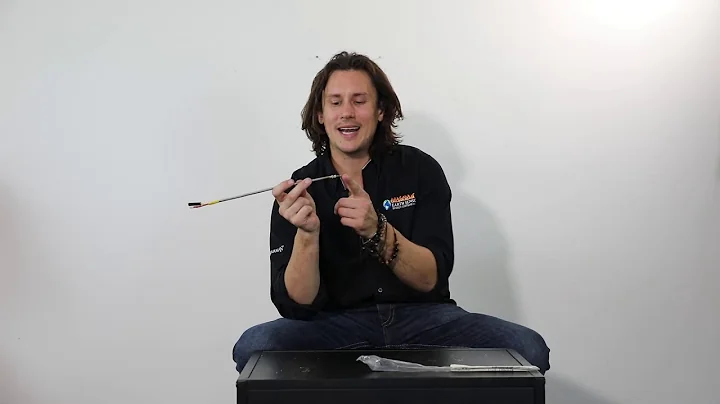Master the Art of Raglan Sleeve Pattern Making
Table of Contents
- Introduction
- Different Types of Raglan Sleeves
- Checking the Shoulder and Armhole
- Drafting the Front Raglan Sleeve Pattern
- Drafting the Back Raglan Sleeve Pattern
- Attaching the Front and Back Sleeves
- Conclusion
- Subscribe to the Channel
Introduction
In this tutorial, I will guide you through the process of drafting basic raglan sleeve patterns. Raglan sleeves are commonly used in t-shirts, blouses, jackets, and coats, and they come in various styles and designs. Construction-wise, there are different approaches to creating a raglan sleeve, such as making a seamless sleeve without a shoulder seam or incorporating a dart on the shoulder. Some raglan sleeves have angled shoulders, while others have shoulder seams that extend to the hem. In this tutorial, we will focus on drafting a simple straight raglan sleeve pattern. So let's get started!
Different Types of Raglan Sleeves
Before we dive into the pattern drafting process, let's take a moment to explore the different types of raglan sleeves. Raglan sleeves can be found in winter coats or trench coats, where the sleeves are straight down similar to set-in sleeves. There are also variations with angled shoulders or a front and back sleeve design. Each type of raglan sleeve brings a unique style to the garment.
Checking the Shoulder and Armhole
Before we begin drafting the raglan sleeve pattern, it's important to check the shoulder and armhole measurements. When you align the underarm points of the front and back patterns, you may notice that the front armhole is often shorter than the back armhole. This difference is perfectly normal. However, if the front shoulder is higher than the back shoulder, adjustments may need to be made. Additionally, it's important to ensure that the angle of the shoulder lines matches when creating a raglan sleeve pattern. We will discuss the importance of this later in the tutorial.
Drafting the Front Raglan Sleeve Pattern
To start drafting the front raglan sleeve pattern, you'll need to draw a design line. Begin by deciding where the line starts on the neck and swing the ruler until it intersects with the armhole line. Mark that point, as it will be crucial in creating the pattern. To mirror the curve along the guideline, draw a perpendicular line and measure the same distance. Copy the line symmetrically. Next, extend the shoulder line to the desired length, keeping in mind that this example uses a length of 14 inches. Draw a perpendicular line at the end of the extended shoulder line. The length of this line will be half of your sleeve hem. Connect this point to the underarm point and make a single notch. Repeat this process for both the front body and the sleeve.
Drafting the Back Raglan Sleeve Pattern
Moving on to the back raglan sleeve pattern, start by deciding where you want the line to start on the neck. Swing the ruler until it intersects with the armhole line and mark that point. Mirror the curve along the guideline. Extend the shoulder line to match the length of the front shoulder line. Draw a perpendicular line at the end of the extended shoulder line. The length of this line will also be half of your sleeve hem. Connect this point to the underarm point and make a double notch. The back body will be represented in brown, while the back sleeve will be represented in purple.
Attaching the Front and Back Sleeves
When you put the front and back patterns on top of each other and align the underarm points, you will notice that the shoulder lines are different. This is expected, as we saw in the beginning. However, since we fixed the shoulder lines to be the same angle, the lines are parallel. This step is crucial because we will be attaching the front sleeve and back sleeve to create one seamless sleeve. If the angles of the two shoulder lines were not the same, the sleeve would twist in the final garment. By ensuring the angle consistency, we guarantee a clean finish.
Conclusion
In conclusion, understanding how to draft basic raglan sleeve patterns is an essential skill for any pattern maker. By following the steps outlined in this tutorial, you can create various styles of raglan sleeves for t-shirts, blouses, jackets, and coats. Remember to check the shoulder and armhole measurements, as well as maintain consistent angles when attaching the front and back sleeves. With practice and experimentation, you can create unique and stylish garments with raglan sleeves.
Subscribe to the Channel
If you found this tutorial helpful and want to learn more about pattern making, make sure to subscribe to our channel. Your support will help us reach more young professionals and take their pattern making skills to the next level. Don't forget to hit the like button and have a great week! See you next time.
Highlights:
- Learn how to draft basic raglan sleeve patterns
- Explore different types of raglan sleeves for various garments
- Check shoulder and armhole measurements for accurate pattern drafting
- Step-by-step guide to drafting front and back raglan sleeve patterns
- Attach front and back sleeves to create a seamless sleeve
- Tips for achieving a clean finish and avoiding sleeve twisting
- Subscribe to the channel for more pattern making tutorials
FAQ:
Q: Can I use raglan sleeves for any type of garment?
A: Yes, raglan sleeves can be used in various garments, including t-shirts, blouses, jackets, and coats. They offer a unique design element and can be customized to suit different styles.
Q: Do I need to make any adjustments to the shoulder and armhole measurements?
A: In most cases, the front armhole will be slightly shorter than the back armhole. This is normal and doesn't require adjustments. However, if the front shoulder is higher than the back shoulder, modifications may be necessary.
Q: Why is it important to match the angle of the shoulder lines when creating a raglan sleeve?
A: Matching the angle of the shoulder lines ensures that the sleeve sits properly on the garment and prevents twisting. When the angles are inconsistent, the sleeve may become distorted or uncomfortable to wear.
Q: Are there different variations of raglan sleeves?
A: Yes, there are various types of raglan sleeves, including those with angled shoulders, seamless sleeves, and front and back sleeve designs. Each variation offers a different aesthetic and can be chosen based on the desired style of the garment.
Q: Can I experiment with different sleeve lengths and widths when drafting raglan sleeves?
A: Absolutely! Once you have mastered the basic raglan sleeve pattern drafting, you can experiment with different sleeve lengths, widths, and design elements. Let your creativity guide you and have fun with the process.
Resources:







